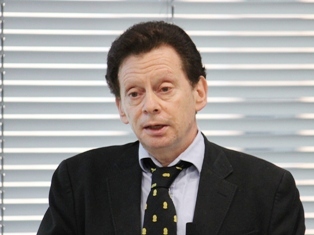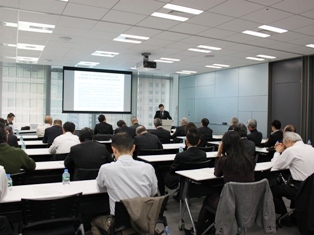イベント開催報告 国際交流
CIGSセミナー「Asset Price Inflation - a global economic virus which has its origins always in the Federal Reserve」開催報告
2013年11月28日(木)
15:00
~ 16:30
開催
会場:キヤノングローバル戦略研究所 会議室3



(左からDr. Brendan Brown、小林氏)
発表資料 (英語)
Presentation by Dr. Brendan BrownPDF:241KB
開催概要
題目: "Asset Price Inflation - a global economic virus which has its origins always in the Federal Reserve"
発表者: Dr. Brendan Brown
(Executive director/head of economic strategy at Mitsubishi UFJ Securities International plc.)
モデレーター: キヤノングローバル戦略研究所 研究主幹 小林 慶一郎
発表概要
The talk is based on Dr. Brown's recently published book "The Global Curse of the Federal Reserve" (2nd edition) and soon to be published book "Euro Crash: how asset price inflation destroys the wealth of nations."
What do we know about the virus of asset price inflation? In particular, what is the link between monetary disorder and irrational exuberance? What is the relationship between asset price inflation and that other monetary virus which attacks the market economy, goods and services inflation? How is the Federal Reserve the source of asset price inflation and how does it spread through the global economy? What defence does the rest of the world possess against such virus attacks from the US and why has this (defence) been so weak?
These questions are answered both in terms of theory and in terms of historical evidence drawn from the 100 years of the Federal Reserve's existence. Particular emphasis is placed on Europe's exposure to US-origin asset price inflation, with focus on the two episodes of German boom-and-bust in the 1920s and EMU boom-and-bust in the 2000s.
The talk finishes with a view to the present and future. Are there distinct features about the Bernanke-ite asset price inflation virus and what damage will this ultimately inflict on the global economy? What is the danger of a sudden mutation of asset price inflation into deflation as occurred in the much discussed historical precedent of 1937?
発表者略歴
Brendan Brown is executive director/head of economic strategy at Mitsubishi UFJ Securities International plc. He is also an Associate Scholar at the Mises Institute (USA).
His areas of special expertise include monetary theory, European monetary integration, the global flow of capital, the Japanese economy, and international financial history.
He has developed unique tools for market analysis and recommendations for investment strategy based on a distillation of Chicago and Austrian School monetary economics.
